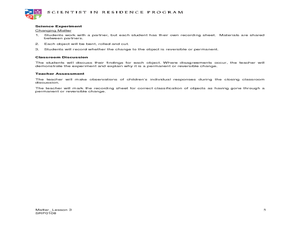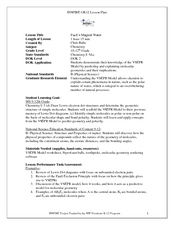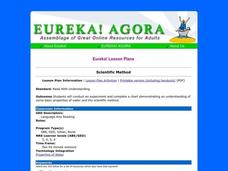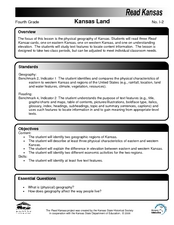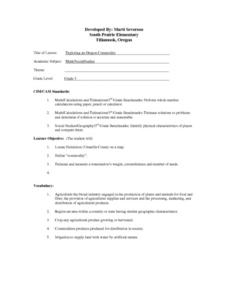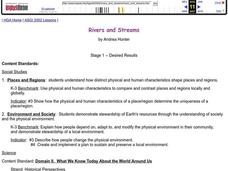Curated OER
Sometimes, solid + liquid = gas
Third graders experiment with common household liquids and solids. In this chemical reaction lesson, 3rd graders discuss phase changes and experiment to find other ways to create gases. They use water, vinegar, lemon juice, flour, baking...
Curated OER
Will It Sink Or Float?
Have your class predict whether objects will sink or float in water. Learners consider a data table of mass, volume and whether the object sank or floated. They develop an evidence-based explanation for the results.
Curated OER
The Human Impact on the Environment
Despite the typos and formatting issues, the Word document found here has some great potential. There are two questions that ask learners to put several events in a logical order; these could easily be made into a card sort activity....
Curated OER
Alcohols, Phenols, and Ethers
Twelve pages of text tells viewers about the physical properties and naming procedures for alcohols and ethers. A page is also dedicated to briefly describing phenols. This straightforward chemistry presentation comes to you as a PDF...
Curated OER
Physical Changes to Matter
Pupils explore matter by conducting an in-class experiment. They experiment with water's various forms by melting and freezing water, identifying its new shape. These observations are recorded to supplement later discussion. They also...
Curated OER
Water
In this water activity, students compare and contrast elements and compounds. Students define chemical symbols, chemical formulas, and chemical properties. This activity has 19 short answer questions.
Curated OER
Colligative Properties Worksheet
In this solutions activity, students determine the boiling points and melting points of solutions. Students calculate the effective molality of a solute. This activity has five problems to solve.
Curated OER
Color Dots 3
Students make simple observations, test mixtures, and make generalized inferences from their observations. They observe bleeding of colored inks with water.
Curated OER
Pauli's Magical Water
Pupils predict the shape of molecules using VSEPR theory. In this chemistry lesson, students differentiate a polar and nonpolar molecule. They discuss why water's polarity is very important.
Curated OER
Scientific Method
Students explore the steps in the scientific methods. Through activities, students discover the scientific is a tool for solving problems of any kind. Students will fill out a scientific method chart, and determine what information is...
Curated OER
Kansas Land
Fourth graders discover the geographic regions of Kansas. In this geography lesson plan, 4th graders explore the different regions of Kansas and determine how the different geography affects daily life in Kansas.
Curated OER
Decision Making - A Mock Town Meeting on a Proposed Tank Farm
Students engage in a instructional activity that is concerned with the establishment of a tank farm. They focus upon the issue in class discussion in the form of a mock town meeting. Students come up with possible solutions to its...
NOAA
Ocean Layers II
Now that you know the ocean has layers, let's name them. The seventh installment of a 23-part NOAA Enrichment in Marine sciences and Oceanography (NEMO) program covers terminology associated with ocean layers, such as thermocline and...
Teach Engineering
Density Column Lab - Part 2
Groups suspend objects within layers of liquids to determine the densities of different liquids and compare them to the densities of objects calculated in Part 1. The groups then carefully test their calculations by layering the...
Curated OER
Review Set
The topics covered in these multiple choice questions are about atomic structure and bonding, state configurations, pressure and solution concentration, and energy graphs. This is a midterm review which could be used with the whole...
Curated OER
Swirling and Churning Milk
Students examine the concepts of micelles, polarity, solubility, and properties of detergent in an experiment with milk, water, and food coloring. Students complete a Take-Home Challenge in which they experiment with the behavior of food...
Curated OER
The Geography - Writing Connection
Pupils examine and describe the four physical systems of the Earth. Using two of the systems, they practice their writing skills and use vocabulary associated with the different types of landforms. They predict the types of shelters are...
Curated OER
Phases of Matter
Students are introduced to the basic states of matter: solids, liquids and gases. Through experimentation, students determine that liquids and solids have definite volume, that gases do not have definite volume, and that solids have a...
Curated OER
Exploring and Oregon Commodity
A fun (and delicious!) lesson teaches measurement to your third graders. They work in small groups to first predict, then to measure the weight, circumference, and number of seeds found in a watermelon. Everyone gets to eat watermelon...
Curated OER
Demonstration of Ideal Gas Law
You know that liquid nitrogen turns into a gas at room temperature. Place some in a two-liter bottle for a physics demonstration of the ideal gas law. Beware, however; this is a dangerous demonstration! Not to mention that you may not...
Curated OER
Rivers and Streams
Young scholars research the rivers, streams and water bodies of Hawaii. They read a variety of books, play Bingo with water-related terms, create and maintain water-themed journals, view videos, conduct Internet research and participate...
Curated OER
Acids and Bases
In this acids and bases worksheet, students compare the properties of acids and bases. Students determine the concentrations required to neutralize solutions. This worksheet has 1 word problem and 14 multiple choice questions.
Curated OER
Acids and Bases
In this acids and bases worksheet, students will identify the molecules represented in a diagram equation and determine if an acidic or basic solution has been produced. Students will list the properties of acidic and basic solutions....
Curated OER
Chemical Changes
Learners compare types of chemical change. In this chemical reaction lesson, students use a variety of household items to investigate different types of chemical change. Learners will engage in a discussion about the dangers of chemicals...






